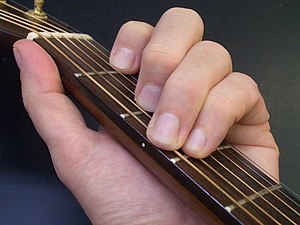Saturday, 6 November 2010
Easy Guitar Lessons: Three Basic Techniques
Three basic techniques to get you going
There are three basic techniques you need to learn in order to begin playing your favourite guitar songs. Technique one: Guitar chords are the foundation for all acoustic guitar songs. Technique two: the strumming technique: and Technique three: shifting between chords. Master these three techniques and you will be able to play some of the most popular songs ever produced by some very famous artists.
Technique One: Guitar Chords
The quickest way to get started as a beginner is to learn at least three simple major chords, such as D, C and G major or C, F and G major. These simple chords will give you the basic foundation for learning easy and well-known songs on the guitar. Framing the shape of each guitar chord will require quite a bit of practice and patience; but once you master them you will not be disappointed because the guitar world will slowly open to you. When you practice consistently you will build up the strength required in the muscles; you will also develop chord-memory in the hands especially if you are a beginner. What does this mean? It means that the more you practice chord shapes the more your fingers will assume the chord shape quickly without conscious effort - it becomes automatic and natural.
One of the best ways to practice each chord is to frame each chord without strumming; press hard to develop the muscles and re-frame each chord again and again. Do this for each of these three major chords.
Technique Two: Strumming
Once you have mastered the basic chord shapes then you need to learn how to strum. Again this will require practice and patience. Timing, rhythm and coordination are all part of good technique requiring consistent practice. You will need a soft pick to start off with and learn how to hold it (search Youtube for basic lessons). I don't use a pick because I grow and shape the finger nail on my right hand.
For me, strumming is part wrist and part elbow movement and sometimes it is just in the wrist or in the elbow. You will need to experiment with this to figure out what is best for each song. The most basic strum is simply a down-stroke (D) to which you can add an up-stroke (U). A pattern that is worth exploring as a beginner is a combination of the down and upstrokes which looks like this: D DU UD. The DU is a down and upstroke played one after the other as a pair; likewise with the UD.
You should practice this strum without a guitar to get an idea of the technique; then practice it with the strings muted. Once you are comfortable you can then practice with your three major chords. The key is to complete the chord sequence of D DU UD before you move to the next chord.
Technique Three: Shifting between Chords
Finally, shifting between each chord is also an important technique a beginner needs to master. Again, shifting from one chord to another chord will take practice and patience. For a beginner, it is best to start by practising without strumming. First frame the chord, for example the D major, then shift to the next chord the C major without strumming, then shift to the third chord, the G major without strumming, then shift back to the D major. Perform this simple exercise many times without strumming and in time. Once you become familiar with each chord structure you can mix it up: D to G to C and so on.
Easy Acoustic Guitar Songs to Learn
Once you have learnt these basic techniques of framing three major chords, basic strum techniques and shifting easily between each chord, then you can learn to play some easy acoustic guitar songssuch as Sweet Home Alabama by Lynyrd Skynyrd, Bad Moon Rising by Creedence and Brown Sugar by the Stones and many more.
Play Acoustic Blues Guitar
Related articles
Subscribe to:
Post Comments (Atom)



No comments:
Post a Comment